Today was a good day for Max and I. As usual for a Saturday, Max and I practiced with the drill team from the Warhorse Militaria and Heritage Foundation at Gabriellano Park. Last Saturday,the Satna Ana winds seemed to affect the horses a bit, making them a bit edgy, and for Max, he didn't want to sidepass in line with the other horses to the point where he was backing up and rearing. Not fun.
During the week, I practiced sidepassing for several days, mixed in with a lot of other manuevers (primarily transitions). I would do only a few at a time and in each instance only have Max move one or two steps and then come to a complete halt. We'd pause and the move another one or two steps (it seems like taking two steps is a bit easier). The thing is to not rush it and to instill in Max the idea that it's not something to be rushed through at speed. Also, it's essential to balance one's seat and to not "ride the horse" by putting tension on the reins and tightening up your muscles. It's basically like you have to be firm, but not too firm and it can vary from day-to-day and moment-to-moment, depending on the horse (what sort of a "day" they're having).
Max passed this part with flying color this time and he didn't have any issues. It also helped that my riding was a bit more relaxed and I made very effort to collect Max and focus his attention on my rather than the environment around him. Also, we practiced cantering in line, starting with groups of two riders and then building up to 4 and 8 riders in line. It was very interesting and my practice with transitions and collection paid off here as I had to rate Max's speed and especially in going around corners (we were doing canters in a wide circle.
What was even more interesting was that it becomes more difficult to do a controlled canter in a longer line than in a shorter line. Max normally does better on the inside of any circle because he's a slow horse but while cantering in a line 8 riders abreast, I literraly had to bring him down to a walk (Max was the inside horse) while going through most of the turn and then speed up to match the outside horses' speed when opening into the straightaway.
I was pretty amazed at the results.
Also, my transition work paid off in brining Max through his various manuevers where we would alternatively have to speed up into a trot or canter and then slow to a walk. You could get away with using only the reins and bit but it's very crude and hard on the horse's mouth. The most effective way is through transitions and collection (and especially using breath control to communicate with the horse). Reins have a place but they're used more as a means of maintaining contact with the mouth just enough to let the horse know that you're "there".
It's all very interesting stuff and it's taken my riding to a whole new level- all that "dressage stuff" :-) that my friends used to give me trouble about. :-)
During the week, I practiced sidepassing for several days, mixed in with a lot of other manuevers (primarily transitions). I would do only a few at a time and in each instance only have Max move one or two steps and then come to a complete halt. We'd pause and the move another one or two steps (it seems like taking two steps is a bit easier). The thing is to not rush it and to instill in Max the idea that it's not something to be rushed through at speed. Also, it's essential to balance one's seat and to not "ride the horse" by putting tension on the reins and tightening up your muscles. It's basically like you have to be firm, but not too firm and it can vary from day-to-day and moment-to-moment, depending on the horse (what sort of a "day" they're having).
Max passed this part with flying color this time and he didn't have any issues. It also helped that my riding was a bit more relaxed and I made very effort to collect Max and focus his attention on my rather than the environment around him. Also, we practiced cantering in line, starting with groups of two riders and then building up to 4 and 8 riders in line. It was very interesting and my practice with transitions and collection paid off here as I had to rate Max's speed and especially in going around corners (we were doing canters in a wide circle.
What was even more interesting was that it becomes more difficult to do a controlled canter in a longer line than in a shorter line. Max normally does better on the inside of any circle because he's a slow horse but while cantering in a line 8 riders abreast, I literraly had to bring him down to a walk (Max was the inside horse) while going through most of the turn and then speed up to match the outside horses' speed when opening into the straightaway.
I was pretty amazed at the results.
Also, my transition work paid off in brining Max through his various manuevers where we would alternatively have to speed up into a trot or canter and then slow to a walk. You could get away with using only the reins and bit but it's very crude and hard on the horse's mouth. The most effective way is through transitions and collection (and especially using breath control to communicate with the horse). Reins have a place but they're used more as a means of maintaining contact with the mouth just enough to let the horse know that you're "there".
It's all very interesting stuff and it's taken my riding to a whole new level- all that "dressage stuff" :-) that my friends used to give me trouble about. :-)




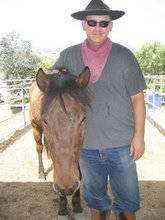
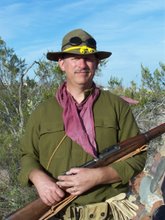
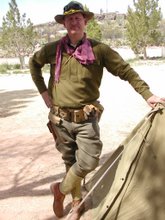
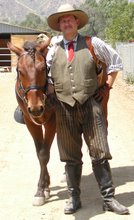
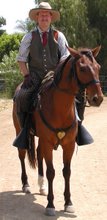

No comments:
Post a Comment